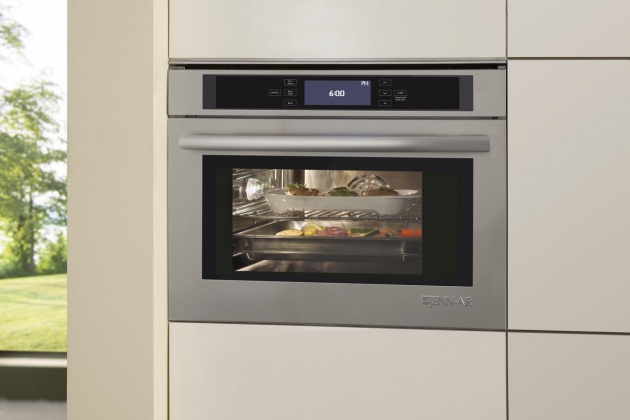When you’re shopping for new kitchen appliances, it can be a little overwhelming when you start to look at the various types of model available. A great example of this is ovens; there are conventional ovens, convection ovens, speed ovens and steam ovens. Steam ovens are a fairly new entry into the consumer kitchen, but can be a great addition to your kitchen. So, here we’ll take a deep dive into steam ovens, their features and benefits.
The Steam Oven Basics:
Steam ovens operate in a similar way to a conventional oven. The radiant heat circulates the hot air throughout the oven interior. When you select steam mode, moisture is injected to create a more humid cooking environment. This water vapor may be added from a water line which is directly connected to your kitchen plumbing or through a water canister that requires manual filling.
While you may be tempted to attempt to recreate this by adding water to a regular oven, this could be potentially dangerous. If you pour water in the bottom of your oven, there is a risk that you will damage the baking element. Additionally, this method will not evenly distribute moisture as a steam oven does so that the food stays hydrated during the entire cooking process.
The Benefits of a Steam Oven:
There are a number of benefits of using a steam oven. These include:
- Healthier, Better Tasting Food: Steaming is one of the healthiest methods of cooking. A steam oven provides a moist environment which prevents the food from drying out. This eliminates the need for adding fat or oil to your food. The flavor is locked in and nutrients that would be lost with convection cooking are retained.
- Efficient Cooking: While convection ovens are considered efficient compared to standard models, steam ovens can cook meals even faster to save even more energy. For example, you can cook a chicken in approximately 20 minutes and then use the browning function to add a roasted finish.
- Prepare Delicate Dishes: A steam oven can provide the perfect environment to bake or cook more delicate items. For example, breads, croissants and pastries can benefit from the environment which will not allow them to dry out.
- Reheat Foods: One of the drawbacks of eating leftovers is that they can become dry and unpalatable. However, the moist conditions in a steam oven means that you can easily reheat foods without compromising on their quality.
Steam Oven vs Microwave:
If you already have a microwave in your kitchen, you may wonder if a steam oven is necessary and whether it is better than your microwave.
While microwaves are the champion of speed cooking, the texture and flavor of dishes prepared in a steam oven are far superior.
Microwaves have a reputation for producing rubbery food if it is even slightly overcooked. Since moisture is included with a steam oven, it guards the food against overcooking, so the texture remains soft and delicious.
Cleaning a Steam Oven:
Steam ovens tend to be easier to clean, due to the moist environment, as you can avoid those hard baked on food remnants. But, because of the condensation, it will need to be more frequently cleaned compared to a regular oven.
You can clean the oven by running a steam cycle for approximately 15 minutes and then wipe down the surfaces using a soft cloth. If there are any tough stains, you can use an appropriate cleaner as per your owners manual. After cleaning, run a final short steam cycle to remove any remaining residue.
If you’re considering a steam oven, you can explore the available options with our online oven and store collection. You can also speak to one of our home appliance specialists who would be happy to guide you through all the available options.

